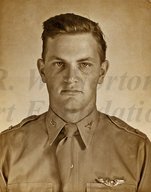
|

|
|
|
|
Charles was born on the farm of his grandfather Thomas south of Magnolia, Arkansas, as the son of Julian and Mattie Thomas Cook. His father was a telegraph operator, but bought a farm east of town in 1926 to raise his family. "He said the farm was the only place to raise boys," Charles recalls. His paternal grandmother, Willie Newton Cook, lived with them. The family grew cotton and corn, raised dairy cattle, and bred hogs with lots of fat for lard, which was used in those times for shortening. Although the Depression years were difficult, the Cooks had "worlds to eat," he says. "It wasn't the best food in the world but on the farm we had plenty of pork and peas and beans and corns and squash." One of his chores was plowing with a mule. "This may sound dumb but hand, eye, body coordination plowing a horse-drawn cultivator or a mule, single-foot, mule-pulled plow, that's pretty good training for pilot's training," he says. Besides his farm chores, Charles also worked part-time at a grocery store on winter afternoons. The family powered the house with a generator and battery that ran a 32-volt DC system. A fireplace provided heat, while his mother cooked on a wood stove. For entertainment and news they enjoyed an Atwater Kent radio. His mother also played piano, sending the children to sleep with works by Chopin, he recalls. Charles graduated from Magnolia High School in 1936 and entered a local school, Agricultural and Mechanical College (now Southern Arkansas University) where he took pre-engineering courses and joined one of two companies of the Arkansas National Guard on campus. Charles rose to the rank of sergeant, while paying for much of his schooling with his monthly pay of about thirty dollars. After graduating from A&M he tried to enter the University of Arkansas, then Georgia Tech, but did not have the money to continue his education. He "liked the idea of the military," he says, where "things were apple-pie order," and applied for flight training at Barksdale Field in Bossier City, Louisiana. Accepted, he was sent to Lincoln, Nebraska, where a civilian contractor taught primary flight training in Stearman PT-13 aircraft. At Maxwell Field in Montgomery, Alabama, he finished basic and advanced flight training and was awarded his wings and commission as second lieutenant on March 14, 1941. On May 29, 1941, he married Mary Hudgens, also from Magnolia. (They would have four children, five grandchildren, and one great-grandchild.) Charles was assigned as an instructor at Gunter Field, also in Montgomery, where he served until January 1, 1943. He was promoted to captain and designated chairman of the flying advisory board, then was named commander of a training squadron. Tiring of the instructor's role, he entered B-24 training in Smyrna, Tennessee, in September of 1943. Charles flew to Great Britain in May of 1944 as part of the 493rd Bombardment Group. Based in Debach, England, he began flying lead crew on missions, carrying sixteen 500- or 800-pound bombs. He flew at heights where temperatures plunged to forty degrees below zero. None of his men were hurt in the war. "Every one of them came back to the States without a scratch," he says. Charles flew twenty-one missions, sixteen in the B-24. He was named Lead Group Training Officer and completed six missions in a B-17. He was by then a major. Charles returned to the states in April of 1945. |


